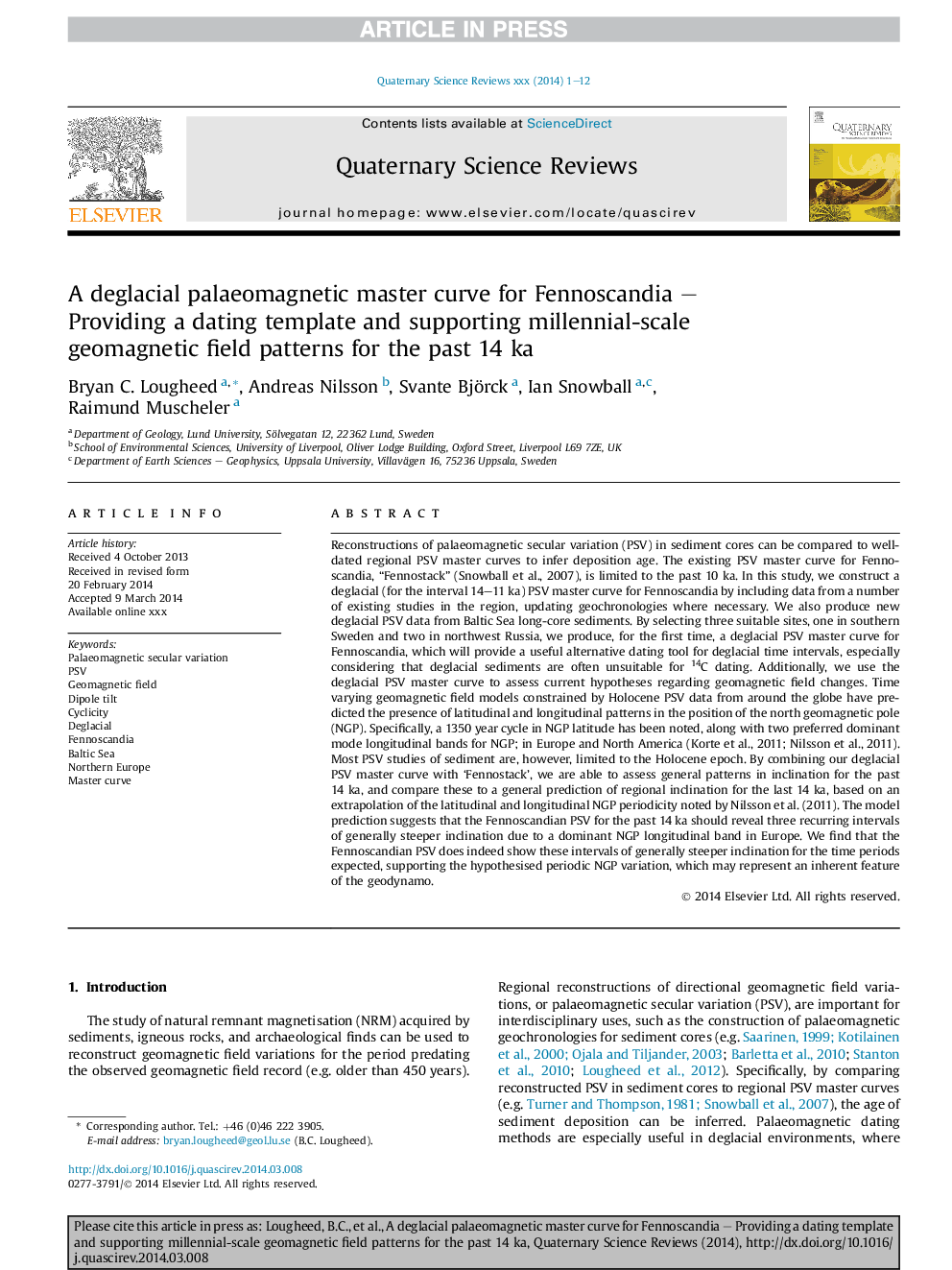| کد مقاله | کد نشریه | سال انتشار | مقاله انگلیسی | نسخه تمام متن |
|---|---|---|---|---|
| 6446088 | 1640828 | 2014 | 12 صفحه PDF | دانلود رایگان |
عنوان انگلیسی مقاله ISI
A deglacial palaeomagnetic master curve for Fennoscandia - Providing a dating template and supporting millennial-scale geomagnetic field patterns for the past 14Â ka
دانلود مقاله + سفارش ترجمه
دانلود مقاله ISI انگلیسی
رایگان برای ایرانیان
کلمات کلیدی
موضوعات مرتبط
مهندسی و علوم پایه
علوم زمین و سیارات
زمین شناسی
پیش نمایش صفحه اول مقاله

چکیده انگلیسی
Reconstructions of palaeomagnetic secular variation (PSV) in sediment cores can be compared to well-dated regional PSV master curves to infer deposition age. The existing PSV master curve for Fennoscandia, “Fennostack” (Snowball et al., 2007), is limited to the past 10 ka. In this study, we construct a deglacial (for the interval 14-11 ka) PSV master curve for Fennoscandia by including data from a number of existing studies in the region, updating geochronologies where necessary. We also produce new deglacial PSV data from Baltic Sea long-core sediments. By selecting three suitable sites, one in southern Sweden and two in northwest Russia, we produce, for the first time, a deglacial PSV master curve for Fennoscandia, which will provide a useful alternative dating tool for deglacial time intervals, especially considering that deglacial sediments are often unsuitable for 14C dating. Additionally, we use the deglacial PSV master curve to assess current hypotheses regarding geomagnetic field changes. Time varying geomagnetic field models constrained by Holocene PSV data from around the globe have predicted the presence of latitudinal and longitudinal patterns in the position of the north geomagnetic pole (NGP). Specifically, a 1350 year cycle in NGP latitude has been noted, along with two preferred dominant mode longitudinal bands for NGP; in Europe and North America (Korte et al., 2011; Nilsson et al., 2011). Most PSV studies of sediment are, however, limited to the Holocene epoch. By combining our deglacial PSV master curve with 'Fennostack', we are able to assess general patterns in inclination for the past 14 ka, and compare these to a general prediction of regional inclination for the last 14 ka, based on an extrapolation of the latitudinal and longitudinal NGP periodicity noted by Nilsson et al. (2011). The model prediction suggests that the Fennoscandian PSV for the past 14 ka should reveal three recurring intervals of generally steeper inclination due to a dominant NGP longitudinal band in Europe. We find that the Fennoscandian PSV does indeed show these intervals of generally steeper inclination for the time periods expected, supporting the hypothesised periodic NGP variation, which may represent an inherent feature of the geodynamo.
ناشر
Database: Elsevier - ScienceDirect (ساینس دایرکت)
Journal: Quaternary Science Reviews - Volume 106, 15 December 2014, Pages 155-166
Journal: Quaternary Science Reviews - Volume 106, 15 December 2014, Pages 155-166
نویسندگان
Bryan C. Lougheed, Andreas Nilsson, Svante Björck, Ian Snowball, Raimund Muscheler,